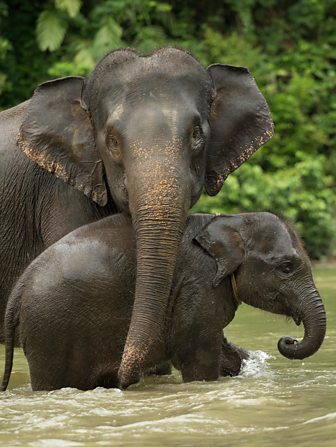Sumatran elephant
(Elephas maximus sumatranus)
| Fact title | Fact data |
|---|---|
| Size |
2,000 to 6,000 kg
|
| Average lifespan |
10 to 15 years
|
| Sexual maturity |
about 7.5 years
|
| Conservation |
Critically endangered
|
| Population |
Fewer than 2,800 (2007)
|
Project Hope Star - Rimbani
On the 1st June 2016 Rimbani, a female elephant calf, was born into a conservation team of elephants known as the ‘elephant flying squad’. These elephants have been rescued by the World Wildlife Fund (WWF) and are too habituated to humans to safely return to the wild. Instead, their skills are put to good use, with mahouts utilising the squad to traverse dense patches of forest to protect wild elephant herds from human conflict, and monitor the forest. They are also used to try and improve relations between humans and elephants. Rimbani will go on her first patrol with the squad, alongside her mother, this March.
Rimbani will go on her first patrol with the squad, alongside her mother, this March
General Info
Sumatran elephants are strictly herbivorous and consume approximately 150 kg (330 lb) of plant matter each day. Sumatran elephants feed on a variety of plants and deposit seeds wherever they go, contributing to a healthy forest ecosystem. Thanks to their large size, they transform the habitat by tearing down trees. This creates gaps in the forest, allowing smaller animals to move around, and sunlight to reach the forest floor.The trunk of a Sumatran elephant contains over 60,000 muscles and is one of the most distinctive features of their body. The trunk is very sensitive and used for everything from breathing, feeding, touching, dusting, watering, grasping, defense, washing, pinching, communication and sound production.
Conservation
The Sumatran elephant is critically endangered. The greatest threats include loss and fragmentation of habitat, human-elephant conflicts, and poaching. In 2012, the status of the Sumatran elephant was changed from “endangered” to “critically endangered” because half of its population was lost in one generation – a decline that is largely due to habitat loss and as a result human-elephant conflict. Sumatran elephants rarely reproduce in captivity. The population is still currently decreasing, but these actions have slowed the decline in the population.





